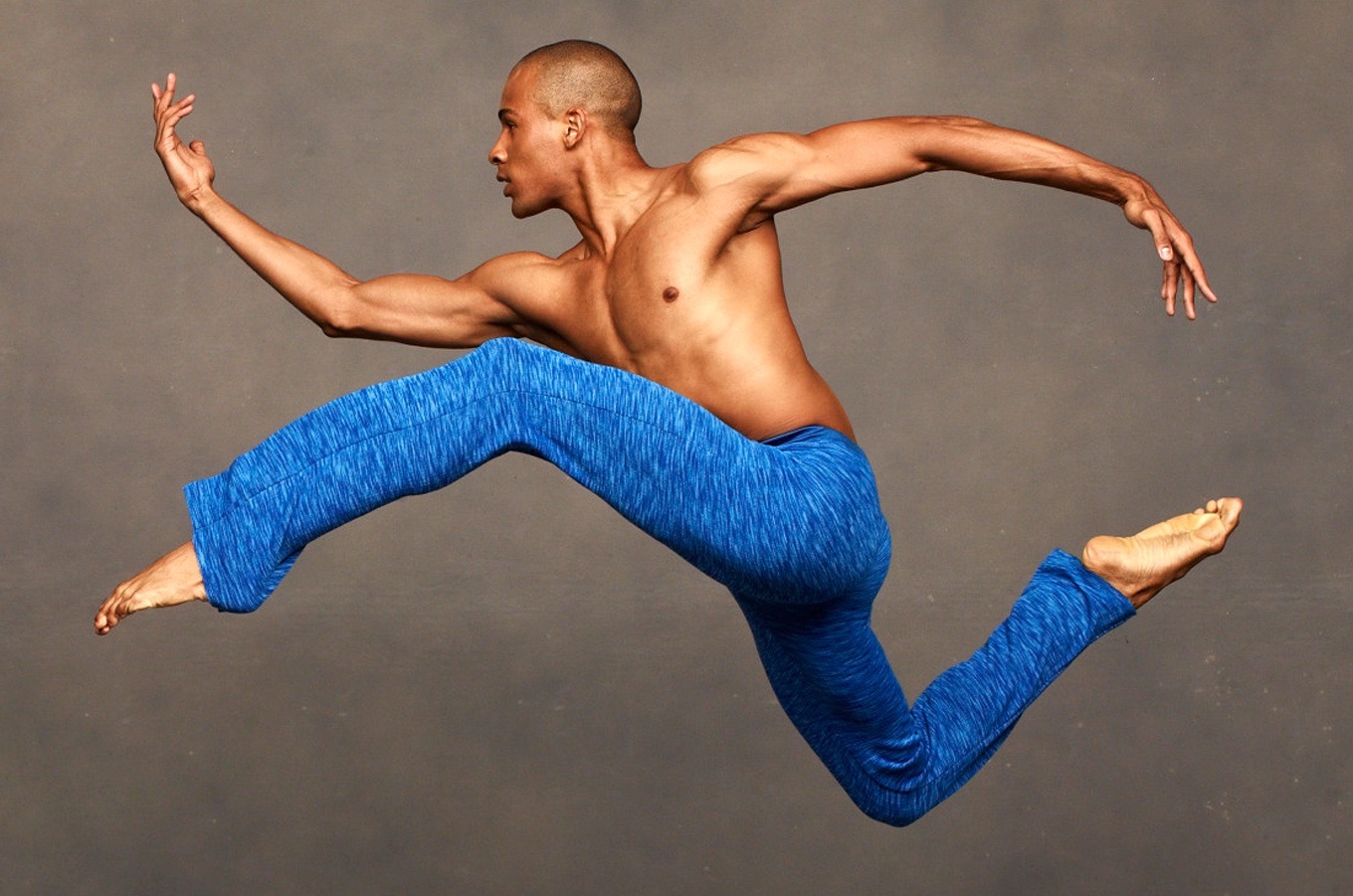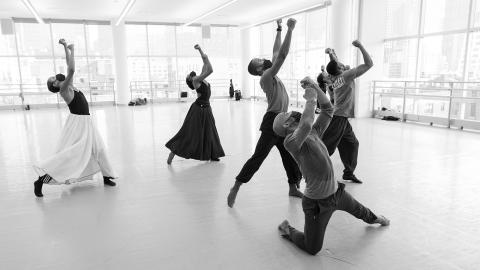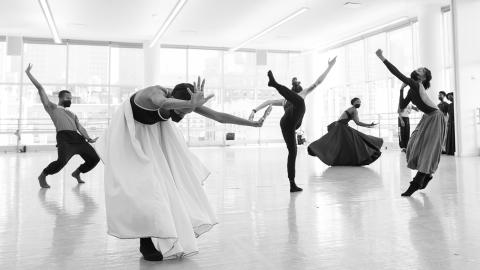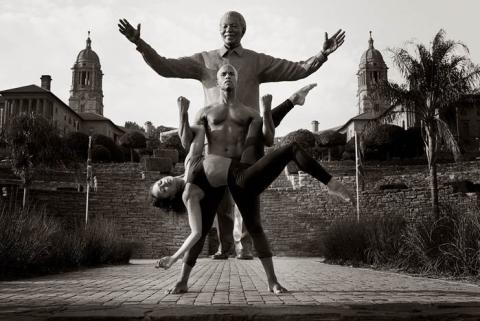The Art and Anguish of Survivors
Posted November 2, 2022
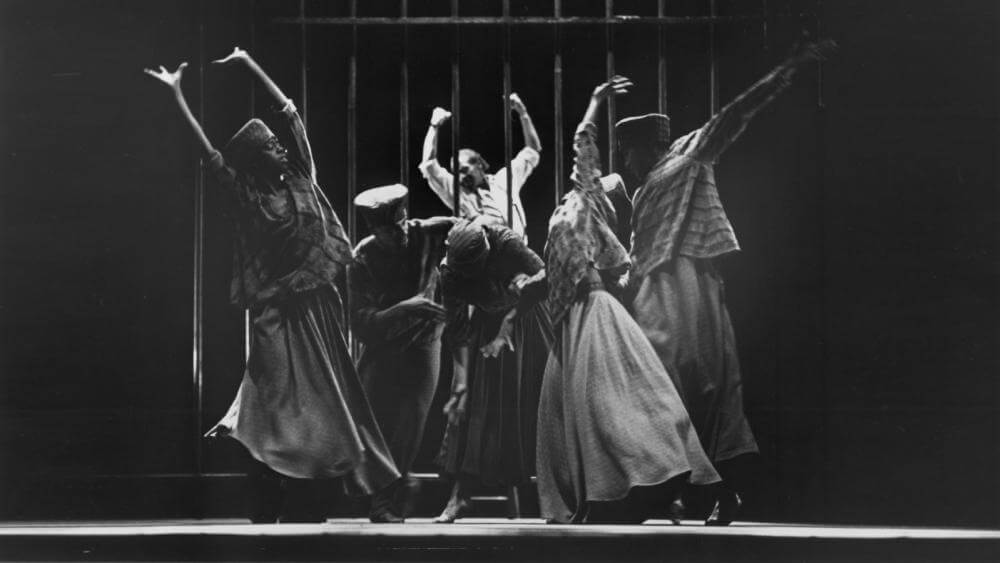
Steel bars. Somber moves. The cry for justice. Survivors, Alvin Ailey’s moving tribute to Nelson and Winnie Mandela, returns to New York City Center
Masazumi Chaya, former Associate Artistic Director, who danced with the Company from 1972-1988 and assisted Mr. Ailey with Survivors, restaged the new production, resurrecting Ailey’s emotional outcry for the inhumane treatment of the South African resistance leaders. “Bringing back any of Mr. Ailey’s work is very important and special for us,” he shares. “The dancers were excited to learn Alvin’s work, and I enjoyed working with them.”
Making A Dance Against Injustice
Alvin Ailey and co-choreographer Mary Barnett’s Survivors captures the torment experienced by the Mandelas. A tribute to the profound courage and terrible anguish of the couple, the ballet is, more broadly, a portrait of people transformed by injustice.
The production features seven dancers, with two representing the anti-apartheid activist duo. Physical bars separate the cast from one male dancer, embodying the heaviness of Nelson Mandela’s 27 years as a political prisoner. “It’s real jail bars, not circles of light that are supposed to imprison,” Mr. Ailey stressed in an interview with the Los Angeles Times in 1987. “Part of the memory, the experience, is in its physical headiness, its heat, its texture, its agony, its abstraction, its sound.”
After its world premiere at the Lyric Theatre in Kansas City, Missouri in 1986, the Company took Survivors on tour—four years before Mandela would finally be freed from prison.
While there wasn’t one single incident that spurred Mr. Ailey’s conception of the work, “This piece is a kind of compendium and abstraction of my rage, an abstraction of that frustration, that anger, that pain,” he told the Times. “It’s about the passing of strength from person to person, the passing on of images and ideas. I was trying to go into the interior of the situation, to the feelings, to say something beyond what we already know about what’s going on there.”
Members of the Company rehearsing Alvin Ailey's Survivors. Photo by Danica Paulos.
The Performance Must Go On
Although Mr. Ailey conceived the work as a message of strength and perseverance, the production was met with threats of violence. “During our spring tour, a phone call came into the theater director’s office at Ruth Eckerd Hall in Clearwater, Florida,” Chaya remembers. “It was scary. The newspapers had reported that snipers had killed people around the Clearwater area that week.”
Even with fear instilled in their hearts, the Company made the decision that the performance should go on. “Alvin wanted to do this ballet because of those prejudices,” Chaya recalls in the 1999 film A Hymn for Alvin Ailey. “We had to fight.”
Acclaimed dancers Dudley Williams and Sharrell Mesh starred in the original production. “That first performance was powerful and poetic. Mr. Williams and Ms. Mesh danced powerfully and gave off strong messages,” Chaya declares. “We did an amazing performance and the audience loved it very much.”
Members of the Company rehearsing Alvin Ailey's Survivors. Photo by Danica Paulos.
Hope, By Design
Mr. Ailey collaborated with Max Roach, who provided Survivors’ score, which includes “Triptych,” composed by the renowned drummer in 1957. Its haunting beat resonates among the screams and wails of jazz singer Abbey Lincoln Aminata Moseka. The production also features Roach’s song “Survivors” (1984) and strings orchestrated by Peter Phillips.
The original décor by Douglas Grekin, costumes by Toni-Leslie James, and lighting by Timothy Hunter, also set an emotional tone for this powerful work that uplifts those who resist oppression in any form.
“I’m hoping that audience members will enjoy the beautiful Alvin Ailey American Dance Theater performance about Mr. Nelson Mandela,” says Chaya. “When you go home, buy the book of his story, or open your smartphone or computer to learn about Mr. Mandela and his history.”
Nelson Mandela: One Man’s Fight for Humanity
Glenn Allen Sims and Linda Celeste Sims in front of the Nelson Mandela Statue at the Union Building in Pretoria, South Africa. Photo by Andrew Eccles.
Nelson Mandela was born on the Eastern Cape of South Africa on July 18, 1918. As a child, Mandela dreamed of contributing to the freedom of his people. In 1944, he joined the African National Congress, the oldest Black political organization in South Africa, where he helped form the ANC Youth League (ANCYL).
During the 1950s, Mandela initially advocated nonviolent resistance to apartheid, South Africa’s institutionalized system of white supremacy and racial segregation. After the massacre of peaceful Black demonstrators at Sharpeville in 1960, Mandela helped organize a paramilitary branch of the ANC. He was instrumental in establishing “Umkhonto weSizwe” (Spear of the Nation), which took a more aggressive approach to establish equality in the country.
Mandela was arrested for illegally leaving the country in 1962 and sentenced to five years at notorious Robben Island Prison, only to be put on trial again in 1964 on charges of sabotage. In June 1964, he was convicted and condemned to life in prison. As a defendant, he made his impassioned, three-hour speech "I Am Prepared to Die."
“I have fought against white domination, and I have fought against black domination. I have cherished the ideal of a democratic and free society in which all persons live together in harmony and with equal opportunities. It is an ideal which I hope to live for and to achieve. But if needs be, it is an ideal for which I am prepared to die.” - Nelson Mandela, April 20, 1964
Mandela spent 27 years as a political prisoner, but never gave up the fight for freedom. He initiated talks about an ultimate meeting between the apartheid government and the ANC, even though he was imprisoned. When South African president Frederik Willem de Klerk and his administration dismantled the apartheid system in the late eighties, Mandela could finally imagine a way out. He gained his freedom on February 11, 1990.
Inaugurated as South Africa’s first democratically elected president on May 10, 1994, at age 75. It marked the first time Mandela had ever been able to vote. He stepped down from the presidency in 1999 and became a philanthropist with a special focus on education. He established the Nelson Mandela Foundation, and pursued noble work such as rural development, school construction, and combating HIV/AIDS. He was awarded a Nobel Peace Prize in 1993 “for their work for the peaceful termination of the apartheid regime, and for laying the foundations for a new democratic South Africa.” Mandela was and continues to be an inspirational leader and his legacy of humility, positive change, and perseverance lives on.
